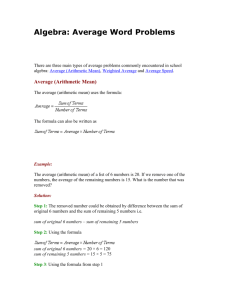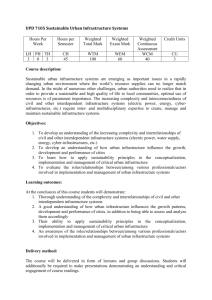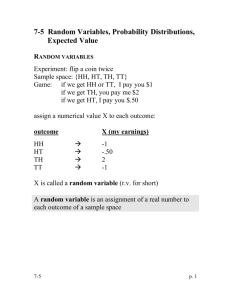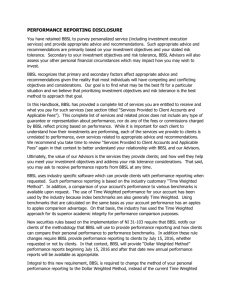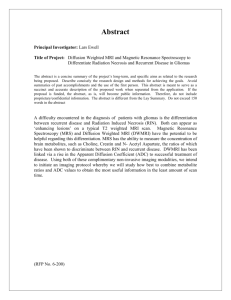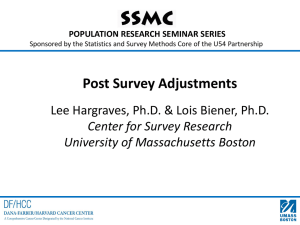Demographic Characteristics and Material Circumstances of New
advertisement
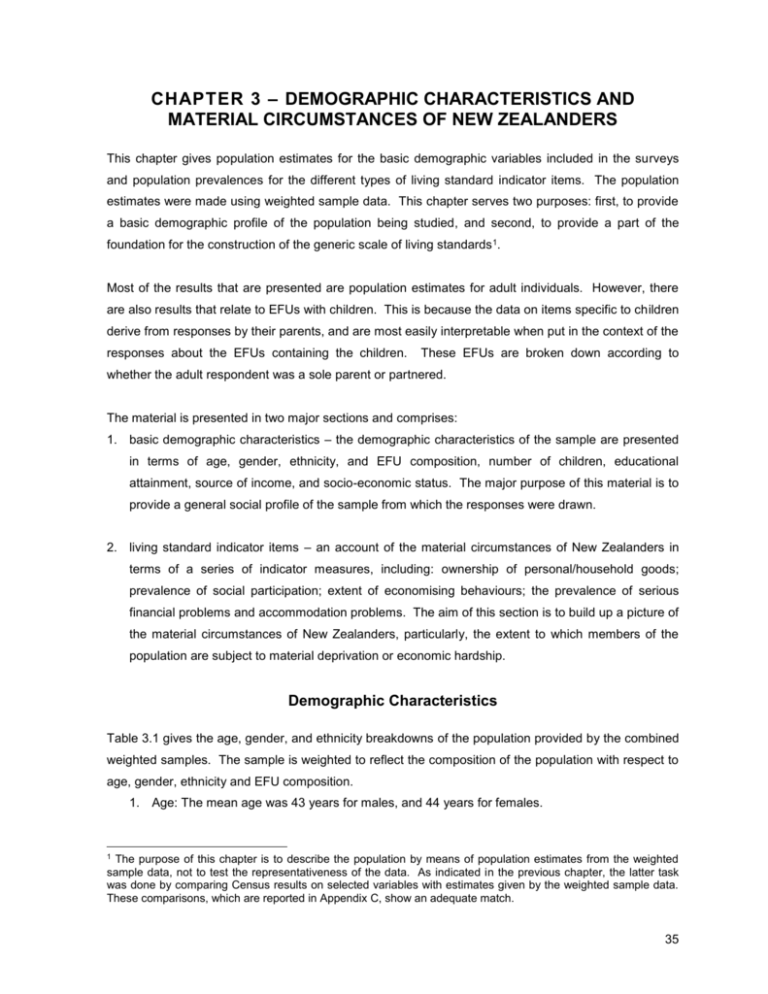
CHAPTER 3 – DEMOGRAPHIC CHARACTERISTICS AND MATERIAL CIRCUMSTANCES OF NEW ZEALANDERS This chapter gives population estimates for the basic demographic variables included in the surveys and population prevalences for the different types of living standard indicator items. The population estimates were made using weighted sample data. This chapter serves two purposes: first, to provide a basic demographic profile of the population being studied, and second, to provide a part of the foundation for the construction of the generic scale of living standards 1. Most of the results that are presented are population estimates for adult individuals. However, there are also results that relate to EFUs with children. This is because the data on items specific to children derive from responses by their parents, and are most easily interpretable when put in the context of the responses about the EFUs containing the children. These EFUs are broken down according to whether the adult respondent was a sole parent or partnered. The material is presented in two major sections and comprises: 1. basic demographic characteristics – the demographic characteristics of the sample are presented in terms of age, gender, ethnicity, and EFU composition, number of children, educational attainment, source of income, and socio-economic status. The major purpose of this material is to provide a general social profile of the sample from which the responses were drawn. 2. living standard indicator items – an account of the material circumstances of New Zealanders in terms of a series of indicator measures, including: ownership of personal/household goods; prevalence of social participation; extent of economising behaviours; the prevalence of serious financial problems and accommodation problems. The aim of this section is to build up a picture of the material circumstances of New Zealanders, particularly, the extent to which members of the population are subject to material deprivation or economic hardship. Demographic Characteristics Table 3.1 gives the age, gender, and ethnicity breakdowns of the population provided by the combined weighted samples. The sample is weighted to reflect the composition of the population with respect to age, gender, ethnicity and EFU composition. 1. Age: The mean age was 43 years for males, and 44 years for females. 1 The purpose of this chapter is to describe the population by means of population estimates from the weighted sample data, not to test the representativeness of the data. As indicated in the previous chapter, the latter task was done by comparing Census results on selected variables with estimates given by the weighted sample data. These comparisons, which are reported in Appendix C, show an adequate match. 35 2. Ethnicity: Most respondents identified themselves as being of European ethnicity. Similarly, most partners/spouses were identified as being of European Ethnicity. 3. Gender: Amongst the respondents there was a slight predominance of females. As a result of the weighting process, these characteristics correspond closely with the population characteristics, as defined by the 2001 Census. Table 3.1: Age, ethnicity, and gender distribution of population (estimated from combined weighted sample) Measure Percent Age (adults and children) Dependent children (under 18 years) 25.9 18 to 24 10.7 24 to 44 31.5 45 to 64 20.5 65 and over 11.4 Ethnicity (adults) Māori 14.0 NZ Pacific 5.8 Chinese 2.0 Indian 1.4 Other 3.8 European 79.7 Gender (adults) Female 50.2 Male 49.8 Note: All values have been estimated from the observed sample weighted to take account of probability of selection, non-response, and sample stratification. Ethnicity does not sum to 100 as groups are not mutually exclusive. Additional analysis of the responses indicated the following general conclusions: 4. EFU Type: Weighted responses indicated that 26.1 percent of EFUs were a single person without dependent children; 25.1 percent were a couple without dependent children; 38.4 percent were a couple with dependent children; 10.4 percent were sole-parent families. 36 5. Number of dependent children: Weighted responses indicated that 63.8 percent of workingage EFUs had no dependent children; 13.0 percent had one dependent child; 14.8 percent had two dependent children; 8.4 percent had three or more dependent children. 6. Educational attainment: Weighted responses indicated that 20.5 percent of adults had attained no school qualifications; 29.7 percent reported that they had attained a qualification at school; 34.8 percent reported that they had attained an occupational certificate or diploma; and 15.0 percent indicated that they had attained a bachelors degree or higher. 7. Source of Income: Weighted responses indicated that for 12.4 percent of the population the main source of income was from New Zealand Superannuation; for 16.0 percent the main source was from an income-tested benefit; and for 71.6 percent the main source was market income; Of those with market income as their main source 61.5 percent received income from were salary and wages only, and the remainder (38.5 percent) received income from selfemployment only. 8. Occupational Distribution: This was classified using the New Zealand Standard Classification of Occupations (NZSCO). Weighted responses indicated that 4.5 percent of main income earners were in Elementary Occupations; 26.3 percent in Trades and Plant and Machine Work; 9.5 percent in Agricultural and Fishery Work; 16.9 in Clerical, Services and Sales Occupations; 27.7 percent in Professional, Assistant Professional, and Technical Work; and 15.1 percent in Legal, Administration or Managerial Occupations. Living Standards Indicator Items The primary focus of the research reported here is on developing a measure of economic living standards based on patterns of ownership, social participation, economising, serious financial problems, and self-ratings of standard of living and adequacy of income. The next chapter describes the ways in which these indicators were scaled to produce a generic scale of living standards. In this section, the background to the subsequent development of the generic scale is presented by reporting the items and their endorsement rates. Ownership and Ownership Restrictions One indicator of living standards is the extent to which people own possessions. As a general rule, those with high living standards are characterised by high levels of ownership of consumer durables and other related resources, whereas those with low living standards lack many of these. These considerations suggest that an assessment of the level of ownership should provide useful information 37 about the overall standard of living of an individual or a family unit. However, it is also clear that there are differing personal preferences for some consumption goods. While almost everyone in New Zealand wants waterproof shoes, not everyone wants a computer. This consideration suggest that information about ownership should be interpreted in the context of the person’s wants and preferences as their pattern of ownership will reflect not only their economic circumstances but also their personal preferences. As discussed in the previous chapter, the present research uses the concept of enforced lack (Mack and Lansley, 1985) operationalised as the things one wants but lacks because of cost. Table 3.2 shows the percentage of people in the population who have the given item and the percentage who report an enforced lack of the given item. Table 3.3 shows the same information for sole-parent families and two-parent families. Overall, the responses obtained for the population and for families with children show a high level of ownership for many of the listed items. More than 90 percent of adults had the following items: a warm winter coat, telephone, a good bed, car, a good pair of shoes, washing machine, warm bedding in winter, TV, inside toilet, hot running water, main supplied electricity, and running water. For EFUs with children, more than 75 percent had a child’s bike, wet weather clothing for each child and shoes in good condition for each child. The items for which relatively few people reported ownership include: holiday home, boat, pay TV, and a Playstation (for families with children). 38 Table 3.2: Ownership restrictions -- population (estimated from combined weighted sample) Have Enforced Lack (Want but don’t have – cost) Common Items Percent Percent Holiday home 10 39 Boat 15 23 Pay TV 31 18 PC 49 18 Internet 39 17 Dishwasher 47 14 Waste disposal unit 26 9 Heating in all main rooms 76 9 Home contents insurance 84 9 Clothes dryer 69 9 Food processor 63 7 A best outfit 85 6 Secure locks 87 5 Video player 88 4 Microwave 86 4 A warm winter coat 90 4 A good bed 96 3 Stereo 88 3 Car 93 3 A good pair of shoes 97 2 A pet 64 2 Telephone 98 2 Washing machine 98 1 Warm bedding in winter 98 1 TV 98 0 Inside toilet 99 0 Hot running water 99 0 Mains electricity 99 0 Running water 99 0 Note: All values have been estimated from the observed sample weighted to take account of probability of selection, non-response, and sample stratification. 39 Table 3.3: Ownership restrictions – families with children (estimated from combined weighted sample) Two-parent families Common Items Holiday home Have Percent 10 Enforced Lack Percent 48 Sole-parent families Have Percent 4 Enforced Lack Percent 53 Boat 17 30 5 24 Pay TV 31 19 20 32 PC 67 18 35 38 Internet 50 18 26 34 Dishwasher 59 15 29 29 Waste disposal unit 29 10 12 18 Heating in all main rooms 78 9 61 22 Home contents insurance 87 8 56 25 Clothes dryer 80 8 59 22 Food processor 67 8 42 19 A best outfit 83 7 70 18 Secure locks 87 5 79 14 A warm winter coat 91 4 83 9 Microwave 92 3 78 11 A good bed 97 2 85 13 Warm bedding in winter 97 2 94 3 A good pair of shoes 97 2 87 11 Video player 95 2 81 12 Stereo 94 2 86 9 A pet 74 2 61 6 Washing machine 99 1 96 4 Car 99 1 78 16 Telephone 98 1 90 7 Hot running water 99.9 0.1 99 0.7 Inside toilet 99 0.1 98 0.4 TV 98 0.1 97 0.2 Running water 99.8 0.1 99 0.6 Mains electricity 99 0.0 99.6 0.2 Children-Specific Items A Playstation 35 9 32 17 Wet weather clothing 89 4 83 12 A child's bike 80 4 69 12 Shoes in good condition 96 2 91 7 Note: All values have been estimated from the observed sample weighted to take account of probability of selection, non-response, and sample stratification. 40 Social Participation and Participation Restrictions A second type of information that reflects living standards concerns social participation. One possible indicator of low living standards may be that individuals are unable to sustain the level of social contact they would like to maintain. As was the case for patterns of ownership, social participation will not only reflect the individual’s economic circumstances, but also their preferences. For these reasons, in the present study information is gathered on extent of social participation, as well as the extent of enforced lack of social participation. These results are presented in Table 3.4, for the population, and Table 3.5, for families with children. The data suggests that there are very few listed activities that people don’t do because of cost. Less than 10 percent reported that they couldn’t afford to visit a hairdresser once every three months, have a special meal at home once a week, give presents to family and friends, or participate in family activities. These findings extended to children specific items. For example, less than 4 percent report that cost prevents them from having children’s friends over for a meal. This picture of social participation restrictions is reasonably consistent for two-parent families. However, a different picture emerges for sole-parent families. A greater percentage of sole-parent families report that cost prevents them from engaging in social activities than for two-parent families. For example, 58 percent of sole-parent families cannot afford childcare services versus 26 percent of two-parent families. Table 3.4: Social participation restrictions – population (estimated from combined weighted sample) Common Items Do Enforced Lack Percent Percent Have a holiday overseas every 3 years 35 41 Have a holiday away from home every year 63 21 Have a night out once a fortnight 47 17 Visit hairdresser once every 3 months 67 8 Have a special meal at home once a week 56 6 Have family/friends over for a meal once a month 70 5 Have enough room for family and friends to stay 87 5 Gives presents to family/friends 94 3 Participate in family activities 86 2 Note: All values have been estimated from the observed sample weighted to take account of probability of selection, non-response, and sample stratification. 41 Table 3.5: Social participation restrictions – EFUs with children (estimated from combined weighted sample) Enforced Lack Common Items Two-parent families Sole-parent families Percent Percent Have a holiday overseas every 3 years 50 70 Have a holiday away from home every year 25 45 Have a night out once a fortnight 25 29 Visit hairdresser once every 3 months 8 26 Have a special meal at home once a week 8 14 Have enough room for family and friends to stay 7 11 Have family/friends over for a meal once a month 5 11 Gives presents to family/friends 3 7 Participate in family activities 2 3 Children Specific Items Pay for childcare services 26 58 Have children's friends over for meal 7 15 Have children's friends over for birthday party 3 7 Have enough room for children's friends to stay 2 7 Note: All values have been estimated from the observed sample weighted to take account of probability of selection, non-response, and sample stratification. Economising Behaviour A further type of information about living standards is the extent to which individuals restrict their expenditure in key areas such as food, home heating, clothing, and medical care. As in the case of ownership or social participation, it is important to assess the reasons for the deficits in consumption. For example, some people may restrict their consumption patterns out of a sense of frugality rather than because this restriction is an economic necessity. To address these issues, respondents in the study were asked whether in the last 12 months they had restricted their expenditure and consumption in key areas of food, clothing, medical expenses, and so on, because they could not afford the cost of these items. Tables 3.6 and 3.7 show the items, and report the percentage of the population (and for families with children) who reported economising not at all, a little, and a lot for each item. The Table 3.6 shows that a substantial percentage of people report engaging in economising behaviours, particularly in the areas of food and clothing. Approximately 20 percent of the population reported that they put off visits to the dentist a little or a lot because of the cost. As with the previous set of indicators, a similar picture emerges for two-parent families (Table 3.7), but sole-parent families report much more economising. 42 For this group, the percentage of people who report not economising at all is smaller than for twoparent families or for the total population. The impression from these results is that sole-parent families economise their expenditure to a much greater extent than two-parent families. Table 3.6: Economising behaviour – population (estimated from combined weighted sample) Extent of Economising Behaviour Not at all A little A lot Percent Percent Percent Put off buying new clothes 41 35 24 Less/cheaper meat 43 35 23 Less time on hobbies 60 26 14 Postponed/put off visits to dentist 62 20 18 Cut back on trips to shops 63 29 8 Kept wearing old clothes 67 23 10 Bought second-hand clothes 69 21 10 Cut back on visits to family/friends 74 20 7 Postponed/put off visits to doctor 75 17 8 Wear worn out shoes 77 15 7 Relied on gifts of clothing 78 15 7 Cut back/cancelled insurance 79 14 7 Less fresh fruit & vegetables. 83 13 5 Put up with feeling cold 85 12 3 Went without glasses 88 7 5 Stayed in bed for warmth 88 8 3 Not picked up prescription 90 8 2 Not gone to funeral/tangi 91 7 3 Common Items Note: All values have been estimated from the observed sample weighted to take account of probability of selection, non-response, and sample stratification. 43 Table 3.7: Economising behaviours – families with children (estimated from combined weighted sample) Two-parent families Common Items Sole-parent families Not at all A little A lot Not at all A little A lot Percent Percent Percent Percent Percent Percent Put off buying new clothes 30 43 28 15 30 55 Less/cheaper meat 34 37 28 16 32 52 Less time on hobbies 48 35 18 29 28 43 Postponed visits to dentist 52 26 21 35 27 38 Cut back on trips to shops 52 38 10 33 46 20 Bought second-hand clothes 57 30 13 38 27 34 Kept wearing old clothes 59 30 11 39 31 30 Not do training/education 63 22 15 50 23 28 Relied on gifts of clothing 67 23 10 50 28 22 Cut back visits to family 67 25 8 45 38 17 Wear worn out shoes 72 20 8 50 33 17 Put off visits to doctor 72 20 9 50 32 18 Cancelled insurance 75 19 6 68 14 17 Less fresh fruit & vegs. 82 13 5 59 31 10 Put up with feeling cold 85 12 3 67 25 8 Went without glasses 86 8 6 80 9 11 Not picked up prescription 88 9 3 72 20 7 Not gone to funeral/tangi 88 8 4 76 16 7 Stayed in bed for warmth 90 8 2 72 19 9 Children Specific Items Not enough bedrooms 79 13 8 70 12 17 Went without cultural lessons 84 12 4 72 14 14 Not bought books for home 86 11 4 68 17 15 Child wore bad fitting clothes 86 13 1 76 16 8 Child's sport limited 88 9 2 74 17 10 Limited space 88 7 4 79 12 9 Not gone on school outings 93 6 1 77 16 7 Not bought school books 94 5 1 83 10 8 Put off child's visits to doctor 95 4 1 88 9 3 Put off child's visits to dentist 96 3 0 90 8 2 Children share a bed 97 2 1 91 5 3 Child went without glasses 98 1 1 97 2 1 Note: All values have been estimated from the observed sample weighted to take account of probability of selection, non-response, and sample stratification. 44 Serious Financial Problems A well-documented accompaniment of deprivation (and therefore low living standard) is the extent to which people have financial problems that jeopardise the maintenance of basic living conditions (e.g., electricity supply, housing, etc.). To examine this issue, respondents were asked whether they had had various financial problems in the last 12 months. The results are shown in Table 3.8. The most common financial problem amongst the population was borrowing money from friends and family to meet everyday living costs. A relatively high proportion of people (10 percent) also reported that they could not keep up payments for hire purchase and credit cards or payments of electricity, gas, and water. While a similar pattern was observed for two-parent families, there was a marked difference in the amount of serious financial problems experienced by sole-parent families. Table 3.8 shows that 45 percent borrowed money off friends and family to meet everyday living costs; 36 percent could not keep up payments for electricity, gas, and water; and 27 percent could not maintain payments for hire purchases and credit cards. These results indicate that while the population experiences few incidences of the types of serious financial problems measured by these items, a different picture emerges for sole-parent families, with a high incidence of people reporting difficulties in meeting everyday living costs, utility payments, and credit repayments. Table 3.8: Serious financial problems – population (estimated from combined weighted sample) Percent having problem Borrowed money from friend/family to meet everyday living costs 14 Couldn’t keep up payments for hire purchase, credit cards 10 Couldn’t keep up payments for electricity, gas, water 10 Pawned or sold something to meet everyday living costs 7 Couldn’t keep up payments on mortgage, rent 7 Received help (food, clothing, money) from community organisation 5 Note: All values have been estimated from the observed sample weighted to take account of probability of selection, non-response, and sample stratification. 45 Table 3.9: Serious financial problems – families with children (estimated from combined weighted sample) Percent having problem Two-parent families Sole-parent families Borrowed money from friend/family to meet everyday living costs 13 27 Couldn’t keep up payments for hire purchase, credit cards 13 46 Couldn’t keep up payments for electricity, gas, water 12 36 Pawned or sold something to everyday meet living costs 8 17 Couldn’t keep up payments on mortgage, rent 8 21 Received help (food, clothing, money) from community organisation 6 21 Note: All values have been estimated from the observed sample weighted to take account of probability of selection, non-response, and sample stratification. Accommodation Problems The survey questionnaire included items concerning problems with accommodation. As stated in Chapter 1, on the basis of previous research it was not expected that accommodation data would fit into a measurement model specified primarily in terms of enforced lacks and economising behaviours. However, it was expected that such data would show a sizable correlation with a scale based on the latter types of information and might be helpful in interpreting results. Accordingly, population estimates for the accommodation problems are presented below in Table 3.10. Estimates are given separately for adults and families with dependent children. Table 3.10: Accommodation problems – population (estimated from combined weighted sample) Population Draughts Dampness Pollution Noise Plumbing Wiring Interior paintwork Windows Doors Roof Piles Exterior paintwork Fences Paving Other problems 21 19 7 21 11 6 18 15 10 12 5 19 15 10 10 Percent having problem Two-parent families 23 20 6 19 11 6 20 19 10 13 4 22 16 11 11 Sole-parent families 17 19 7 24 12 4 14 10 9 9 5 16 13 8 9 Note: all values have been estimated from the observed sample to take account of probability of selection, nonresponse, and sample stratification. 46 Self-Ratings Another perspective on a person’s living standard can be gained by asking them to provide their own assessment. Table 3.11 reports on three ratings of standard of living for the adult population. Selfratings for families with children are presented in Table 3.12. The first measure asked respondents whether they found their current income adequate to meet their day-to-day living costs. The second measure asked respondents to assess their overall standard of living on a scale ranging from high to low. The third measure assessed respondents’ satisfaction with their standard of living. The third measure was not part of the CFA model fitted by Fergusson et al. (2001) for older people or for the present CFA analysis. However, it is used in later parts of the report for the specification of the general use form of the measure. The questions were: 1. How well does your (or your and your partner’s combined) total income meet your everyday needs for such things as accommodation, food, clothing, and other necessities? 2. Generally, how would you rate your standard of living? 3. Generally, how satisfied are you with your current standard of living? Table 3.11: Ratings of adequacy of income, standard of living, and satisfaction with standard of living – population (estimated from combined weighted sample) Measure Adequacy of Income Standard of Living Satisfaction with Standard of Living Percent More than enough 13.6 Enough 29.7 Just enough 36.9 Not enough 19.8 High 8.0 Fairly high 30.7 Medium 53.5 Fairly low 5.9 Low 1.9 Very satisfied 19.6 Satisfied 52.0 Neither satisfied nor dissatisfied 18.7 Dissatisfied 8.1 Very dissatisfied 1.3 Note: All values have been estimated from the observed sample weighted to take account of probability of selection, non-response, and sample stratification; values may not sum to 100 due to rounding error. 47 Table 3.12: Ratings of adequacy of income, standard of living, and satisfaction with standard of living – families with children (estimated from combined weighted sample) Measure Percent Two-parent families Adequacy of Income Standard of Living Satisfaction with Standard of Living More than enough 9.4 Enough 31.3 Just enough 38.9 Not enough 20.4 High 8.0 Fairly high 34.4 Medium 52.3 Fairly low 3.4 Low 1.9 Very satisfied 20.7 Satisfied 50.7 Neither satisfied nor dissatisfied 19.0 Dissatisfied 8.2 Very dissatisfied 1.4 Sole-parent families Adequacy of Income Standard of Living Satisfaction with Standard of Living More than enough 42.4 Enough 36.4 Just enough 15.8 Not enough 5.4 High 2.9 Fairly high 16.4 Medium 57.2 Fairly low 19.1 Low 4.4 Very satisfied 5.6 Satisfied 36.1 Neither satisfied nor dissatisfied 30.2 Dissatisfied 24.3 Very dissatisfied 3.8 Note: All values have been estimated from the observed sample weighted to take account of probability of selection, non-response, and sample stratification; values may not sum to 100 due to rounding error. 48 Summary The aim of this chapter has been to present a descriptive profile of the populations’ social background and living standards using a representative sample of the population of New Zealand. The chapter showed the following: 1. basic demographic features: The age of the sample ranged from 18 years of age to over 90 years. The sample comprised four major EFU types – sole-parent families; two-parent families; couple-only families; single people – and included people with a range of educational qualifications, occupational status, and income sources. The sample was representative of the New Zealand population. 2. indicators of living standards: To develop a profile of the adult population of New Zealand, data were presented on a number of living standards indicators including: ownership and social participation restrictions, economising behaviour, serious financial problems, and selfratings. The challenge is to find a means of combining the data from the indicators into one measure that summarises satisfactorily the variations in living standards for New Zealanders. Subsequent chapters will describe the ways in which the individual indicator measures that were reported in this chapter were combined using multivariate methods to address this challenge. 49


